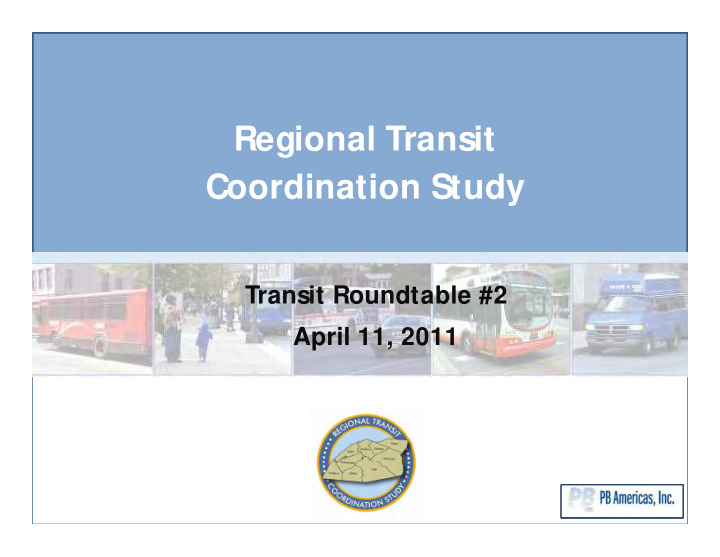



Regional Transit Coordination Study Transit Roundtable #2 April 11, 2011
Welcome Regional Transit Roundtable • 8:00 a.m. Registration and Continental Breakfast • 8:45 a.m. Welcome and Introductory Remarks • 9:30 a.m. Break • 9:45 a.m. Small Group Discussion • 11:15 a.m. Report Back to Larger Group, Wrap Up and Next Steps
Purpose of the Regional Transit Study is to… . Increase mobility options for the region’s residents, employers, visitors and commuters through coordinated service between separate transit agencies and Commuter Services of P A 3
Benefits of Regional Transit Coordination • Reduce congestion and commute time • Better bottom line for transit agencies • Improve air quality; Reduce GHG emissions 4
Benefits of Regional Transit Coordination • Make transportation system more sustainable • Increase access to jobs – companies expand recruiting area 5
Benefits of Regional Transit Coordination The bottom line: An enhanced quality of life for all who live and work in S outh Central Pennsylvania. 6
Study Partners Capital Area Transit (CAT) Lebanon County Planning Department Adams County Transit Franklin County Planning Tri-County Regional Planning Authority Commission Adams County Office of Lancaster County Planning York County Transit Authority Planning and Development Commission Berks County Planning Red Rose Transit Authority York County Planning Commission (Lancaster County) Commission Berks Area Regional County of Lebanon Transit Transportation Authority 7
Progress T o-Date • Determined transit coordination needs • Inventoried travel conditions, demographic trends and travel patterns • Identified potential corridors and connections • First Transit Roundtable held December 14 • Identified potential barriers to implementation 8
Transit Roundtable #2 • Purpose – Involve more stakeholders in discussions concerning • Organizational Framework • Legislation and Funding • Partnerships • Result – A template for implementation 9
Final T en Corridors • Map of corridors 10
Corridor Evaluation Factors • Number of non-single • Incentives to use occupant vehicles transit • Job density • Availability and • Population density capacity of existing • Connects trip origins park and rides and destinations • Provides for transit • Corridor serves zero- connections car households • Ease of • Ability to create implementation public-private • Ability to expand partnerships service • Potential for future population growth 11
Corridor Prioritization 1 st Tier 3 rd Tier 2 nd Tier Corridor Corridor Corridor Service Area Service Area Service Area Name Name Name Berks & Franklin, Lancaster, Brown Lebanon via Cumberland & Lebanon & US-422 Y ellow Purple Dauphin via Dauphin via Adams, Y ork I-81 P A-283 and Gold Cumberland Perry, Dauphin via US-15/ Berks, Lebanon Pink & Cumberland P A-74 Blue & Dauphin via I- via US-11/ 15 Lancaster & 78 and I-81 Orange Y ork via US-30 Adams & Y ork Y ork & Berks & Cyan via Us-30/ PA- Green Cumberland via Red Lancaster via 94/ P A-116 I-83/ PA-581 US-222 12
Barriers to Implementation • Funding! • Intergovernmental agreements • Decision-making authority/ political issues • Community partnerships • Coordinated transportation/ land use planning • Cost and revenue sharing • Branding of equipment • Fare collection • Service issues and delays 13
Case Studies for Potential Solutions Case Studies for Potential Solutions • Over one dozen regions examined • Conversations as well as published materials • Lessons learned – Different practices in different parts of the country – Large MPO or transit agency typically in the driver’s seat – Perceptions different from the public’s perspective vs. behind the scenes 14
Best Practices: Organizational Framework • Direct purchase of transit services • Coordination agreement • Joint powers agreement • Umbrella agency • Intergovernmental agreements • Allocation of costs and revenues/ fare sharing 15
Best Practices: Legislation and Funding • Enabling legislation • New program for funding regional transit • How to provide local match 16
Best Practices: Community Support • Subsidized transit passes • Bus shelters • Park-and-rides • Service planning input • Shuttle service connections • Sidewalks/access to transit 17
Small Group Discussion Agenda • Purpose: work through the potential barriers to implementation • M ethod: – Small group discussions focusing on specific topics – Refer to examples of similar situations elsewhere in US • Report back: sharing of ideas and recommendations to inform implementation plan 18
Breakout Groups Group #1 Group #2 Group #3 Commissioners, Legislators and Business, Not-for- Transit Agency Board PennDOT BPT Staff, profits, Agencies, Members, Transit Transit Agency Staff County Planners, Agency Staff Transit Agency S taff Organizational Legislative and Community Framework: Funding Issues: Support: • Coordinating umbrella • Enabling legislation • Partnerships • New program for agency • Last ½ mile • Intergovernmental funding regional transit • Local match agreements • Allocating costs and revenues/ fare sharing 19
Breakout Group Assignments Group 1 Organizational Framework Lacebark Pine (front) Ryan Furgerson and Chris Jandoli Group 2 Legislation and Funding S cotch Pine (middle) Dennis Louwerse and Anna Lynn S mith Group 3 Partnerships Lodgepole Pine (back) Maggie Mund and S teve Deck 20
Report Back • Each group discuss what heard and conclusions/ recommendations • 10 minutes each 21
Next Steps • Incorporate ideas and comments into Implementation Plan • Identify and refine demonstration corridor • Create guiding policy • Prepare Final Report • Present findings to BARTA and County Commissioners 22
Regional Transit Coordination Study Thank you for your participation! Project website: http:/ / www.pacommuterservices.com/ RTCS.html
Recommend
More recommend